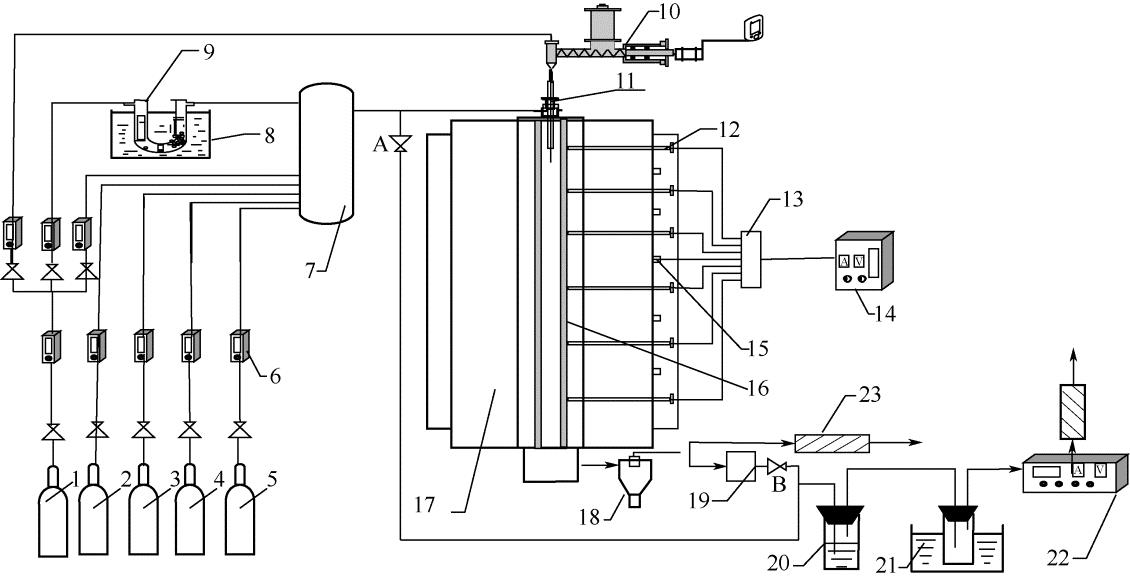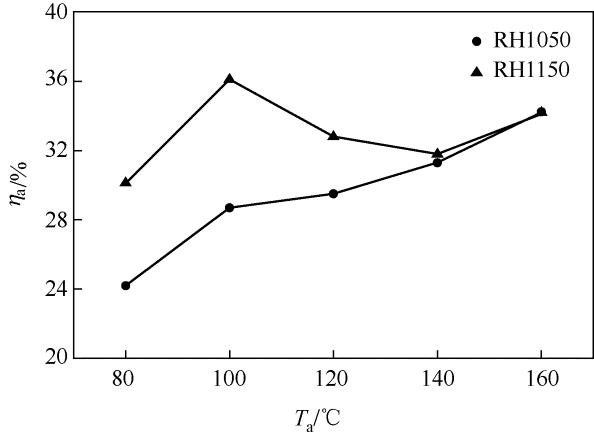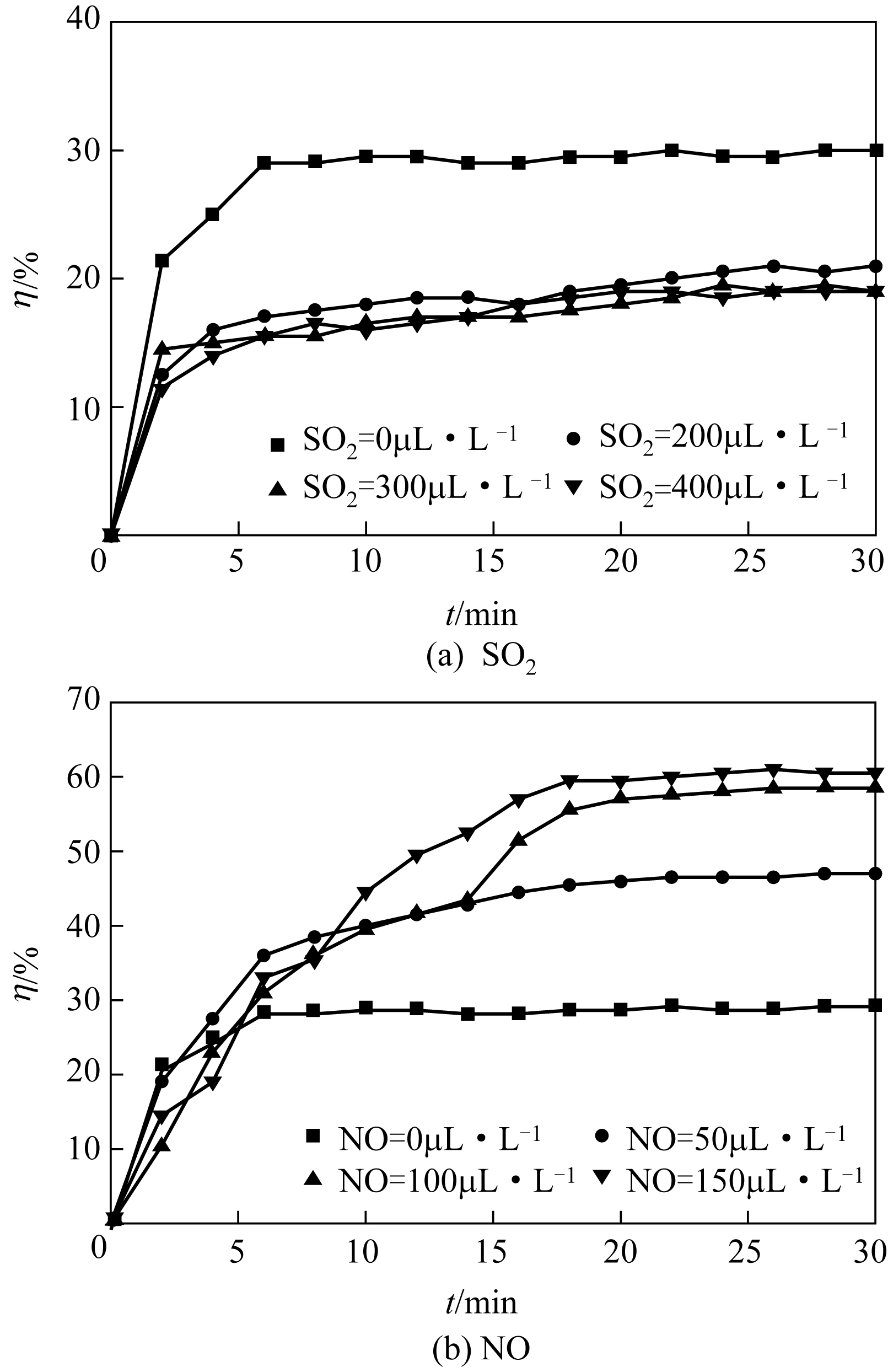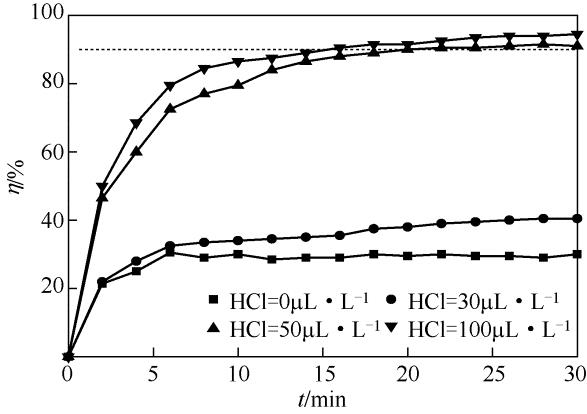Chemical Industry and Engineering Progress ›› 2019, Vol. 38 ›› Issue (05): 2471-2478.DOI: 10.16085/j.issn.1000-6613.2018-1647
• Resources and environmental engineering • Previous Articles Next Articles
In-duct injection mercury removal characteristics of biochar prepared under biomass reburning condition
Ping LU( ),Jiateng SHI,Yangtian YE,Hewei JIANG
),Jiateng SHI,Yangtian YE,Hewei JIANG
- School of Energy and Mechanical Engineering, Nanjing Normal University, Nanjing 210042, Jiangsu, China
-
Received:2018-08-10Revised:2018-09-22Online:2019-05-05Published:2019-05-05
生物质再燃焦管道喷射脱汞性能
- 南京师范大学能源与机械工程学院,江苏 南京 210042
-
作者简介:<named-content content-type="corresp-name">卢平</named-content>(1968—),男,博士,教授,主要从事燃烧及其污染物控制的研究。E-mail:<email>luping@njnu.edu.cn</email>。 -
基金资助:国家自然科学基金(51476079);江苏省高校自然科学研究重大项目(15KJA610002)
CLC Number:
Cite this article
Ping LU, Jiateng SHI, Yangtian YE, Hewei JIANG. In-duct injection mercury removal characteristics of biochar prepared under biomass reburning condition[J]. Chemical Industry and Engineering Progress, 2019, 38(05): 2471-2478.
卢平, 史加腾, 叶扬天, 蒋何伟. 生物质再燃焦管道喷射脱汞性能[J]. 化工进展, 2019, 38(05): 2471-2478.
share this article
Add to citation manager EndNote|Ris|BibTeX
URL: https://hgjz.cip.com.cn/EN/10.16085/j.issn.1000-6613.2018-1647
| 样品 | 工业分析 | 元素分析 | Cl | Y | R1 | ||||||
|---|---|---|---|---|---|---|---|---|---|---|---|
| Ad | FCd | Vd | Cd | Hd | Od | Nd | Sd | ||||
| RH | 13.14 | 17.88 | 68.98 | 44.30 | 6.35 | 35.30 | 0.58 | 0.32 | 0.24 | — | — |
| WS | 9.83 | 17.46 | 72.71 | 39.17 | 5.63 | 42.34 | 2.55 | 0.48 | 0.72 | — | — |
| RH1050 | 66.16 | 22.01 | 11.82 | 28.40 | 1.38 | 3.36 | 0.51 | 0.19 | 0.13 | 19.86 | 89.36 |
| RH1150 | 69.88 | 22.91 | 7.21 | 27.11 | 1.24 | 1.10 | 0.52 | 0.15 | 0 | 18.80 | 100 |
| WS1050 | 52.57 | 38.27 | 9.16 | 42.73 | 1.98 | 2.17 | 0.46 | 0.09 | 0.16 | 18.69 | 95.87 |
| WS1150 | 56.66 | 43.34 | 7.36 | 39.87 | 1.85 | 1.06 | 0.44 | 0.12 | 0 | 17.34 | 100 |
| 样品 | 工业分析 | 元素分析 | Cl | Y | R1 | ||||||
|---|---|---|---|---|---|---|---|---|---|---|---|
| Ad | FCd | Vd | Cd | Hd | Od | Nd | Sd | ||||
| RH | 13.14 | 17.88 | 68.98 | 44.30 | 6.35 | 35.30 | 0.58 | 0.32 | 0.24 | — | — |
| WS | 9.83 | 17.46 | 72.71 | 39.17 | 5.63 | 42.34 | 2.55 | 0.48 | 0.72 | — | — |
| RH1050 | 66.16 | 22.01 | 11.82 | 28.40 | 1.38 | 3.36 | 0.51 | 0.19 | 0.13 | 19.86 | 89.36 |
| RH1150 | 69.88 | 22.91 | 7.21 | 27.11 | 1.24 | 1.10 | 0.52 | 0.15 | 0 | 18.80 | 100 |
| WS1050 | 52.57 | 38.27 | 9.16 | 42.73 | 1.98 | 2.17 | 0.46 | 0.09 | 0.16 | 18.69 | 95.87 |
| WS1150 | 56.66 | 43.34 | 7.36 | 39.87 | 1.85 | 1.06 | 0.44 | 0.12 | 0 | 17.34 | 100 |
| SiO2 | Al2O3 | CaO | Fe2O3 | K2O | TiO2 | MgO | Na2O | SO3 | SrO | MnO | LOI |
|---|---|---|---|---|---|---|---|---|---|---|---|
| 41.44 | 29.1 | 12.39 | 4.49 | 0.97 | 0.90 | 0.89 | 0.70 | 4.60 | 0.14 | 0.06 | 4.32 |
| SiO2 | Al2O3 | CaO | Fe2O3 | K2O | TiO2 | MgO | Na2O | SO3 | SrO | MnO | LOI |
|---|---|---|---|---|---|---|---|---|---|---|---|
| 41.44 | 29.1 | 12.39 | 4.49 | 0.97 | 0.90 | 0.89 | 0.70 | 4.60 | 0.14 | 0.06 | 4.32 |
| 样品 | S BET/m2·g-1 | V M/mm3·g-1 | V T/mm3·g-1 | X/% | D a/nm |
|---|---|---|---|---|---|
| 飞灰 | 1.55 | 0.81 | 2.87 | 28.22 | 7.41 |
| RH | 1.23 | 0.67 | 1.96 | 34.18 | 6.37 |
| WS | 1.28 | 0.66 | 2.11 | 31.28 | 6.59 |
| RH1050 | 176.92 | 93.87 | 111.40 | 84.26 | 2.52 |
| RH1150 | 190.31 | 99.88 | 119.40 | 83.64 | 2.51 |
| WS1050 | 146.27 | 77.05 | 93.12 | 82.74 | 2.55 |
| WS1150 | 169.45 | 89.90 | 113.70 | 79.06 | 2.69 |
| 样品 | S BET/m2·g-1 | V M/mm3·g-1 | V T/mm3·g-1 | X/% | D a/nm |
|---|---|---|---|---|---|
| 飞灰 | 1.55 | 0.81 | 2.87 | 28.22 | 7.41 |
| RH | 1.23 | 0.67 | 1.96 | 34.18 | 6.37 |
| WS | 1.28 | 0.66 | 2.11 | 31.28 | 6.59 |
| RH1050 | 176.92 | 93.87 | 111.40 | 84.26 | 2.52 |
| RH1150 | 190.31 | 99.88 | 119.40 | 83.64 | 2.51 |
| WS1050 | 146.27 | 77.05 | 93.12 | 82.74 | 2.55 |
| WS1150 | 169.45 | 89.90 | 113.70 | 79.06 | 2.69 |
| 1 | HUI M , WU Q , WANG S , et al . Mercury flows in China and global drivers[J]. Environmental Science & Technology, 2017, 51(1): 222-231. |
| 2 | DRISCOLL C T , MASON R P , CHAN H M , et al . Mercury as a global pollutant: sources, pathways, and effects[J]. Environmental Science Technoloy, 2013, 47(10): 4967-4983. |
| 3 | HU Y , CHENG H . Control of mercury emissions from stationary coal combustion sources in China: current status and recommendations[J]. Environmental Pollution, 2016, 218: 1209-1221. |
| 4 | YAN R , LIANG D T , TAY J H . Control of mercury vapor emissions from combustion flue gas[J]. Environmental Science and Pollution Research, 2003, 10(6): 399-407. |
| 5 | MUKHERJEE A B , ZEVENHOVEN R , BHATTACHARY P , et al . Mercury flow via coal and coal utilization by-products: a global perspective[J]. Resources, Conservation and Recycling, 2008, 52(4): 571-591. |
| 6 | 韩粉女,钟秦 . 燃煤烟气脱汞技术的研究进展[J]. 化工进展,2011, 30(4): 878-885. |
| HAN F N , ZHONG Q . Research progress of removal of mercury from coal-fired flue gas[J]. Chemical Industry and Engineering Progress, 2011, 30(4): 878-885. | |
| 7 | XU Y , ZENG X , ZHANG B , et al . Experiment and kinetic study of elemental mercury adsorption over a novel chlorinated sorbent derived from coal and waste polyvinyl chloride[J]. Energy & Fuels, 2016, 30(12): 10635-10642. |
| 8 | LIU Z , YANG W , XU W , et al . Removal of elemental mercury by bio-chars derived from seaweed impregnated with potassium iodine[J]. Chemical Engineering Journal, 2018, 339(1): 468-478. |
| 9 | SI H L , RHIM Y J , CHO S P, et al . Carbon-based novel sorbent for removing gasphase mercury[J]. Fuel, 2006, 85(2): 219-226. |
| 10 | DE M, AZARGOHAR R , DALAI A K . Mercury removal by bio-char based modified activated carbons[J]. Fuel, 2013, 103: 570-578. |
| 11 | SHU T , LU P , HE N . Mercury adsorption of modified mulberry twig chars in a simulated flue gas[J]. Bioresource Technology, 2013, 136: 182-187. |
| 12 | LI G , WANG S , WANG F , et al . Role of inherent active constituents on mercury adsorption capacity of chars from four solid wastes[J]. Chemical Engineering Journal, 2017, 307: 544-552. |
| 13 | 任建莉, 周劲松, 骆仲泱,等 . 活性碳吸附烟气中气态汞的试验研究[J]. 中国电机工程学报, 2004, 24(2): 171-175. |
| REN J L , ZHOU J S , LUO Z Y , et al . Experimental study on adsorption of gaseous mercury in flue gas by activated carbon[J]. Proceedings of the CSEE, 2004, 24(2): 171-175. | |
| 14 | 洪亚光,段钰锋,朱纯,等 . 载硫椰壳活性炭喷射脱尿实验研究[J]. 工程热物理学报,2015, 36(5): 1135-1138. |
| HONG Y G , DUAN Y F , ZHU C , et al . Experimental study on mercury adsorption of S-impregnated coconut shell activated carbon by duct injection[J]. Journal of Engineering Thermophysics, 2015, 36(5): 1135-1138. | |
| 15 | SERRE S D , SILCOX G D . Adsorption of elemental mercury on the residual carbon in coal fly ash[J]. Ind. Eng. Chem. Res., 2000, 39(6): 1723-1730. |
| 16 | LU P , HAO J , YU W , et al . Effects of water vapor and Na/K additives on NO reduction through advanced biomass reburning[J]. Fuel, 2016, 170: 60-66. |
| 17 | BALLESTER J , ICHASO R , PINA A , et al . Experimental evaluation and detailed characterisation of biomass reburning[J]. Biomass & Bioenergy, 2008, 32(10): 959-970. |
| 18 | 史加腾, 尹欣怡, 卢平, 等 . 再燃温度对稻壳焦理化结构演变的影响[J]. 燃料化学学报, 2017, 45(8): 924-931. |
| SHI J T , YIN X Y , LU P , et al . Effect of reburning temperature on physico-chemical characteristics evolution of rice husk char[J]. Journal of Fuel Chemistry & Technology, 2017, 45(8): 924-931. | |
| 19 | 郝江涛, 于伟, 卢平, 等 . 生物质高级再燃脱硝的影响因素与元素释放特性[J]. 燃料化学学报, 2014, 42(5): 552-559. |
| HAO J T , YU W , LU P , et al . The influence factors and element release properties of NO reduction through biomass advanced reburning[J]. Journal of Fuel Chemistry and Technology, 2014, 42(5): 552-559. | |
| 20 | 鲁许鳌, 冉旭, 郑小龙, 等 . 热解温度对生物质半焦特征的影响[J]. 动力工程学报,2012, 32(11): 865-870. |
| LU X A , RAN X , ZHENG X L , et al . Effects of pyrolysis temperature on characteristics of biomass char[J]. Journal of Chinese Society of Power Engineering, 2012, 32(11): 865-870. | |
| 21 | 周军, 张海, 吕俊复, 等 . 高温下热解温度对煤焦孔隙结构的影响[J]. 燃料化学学报, 2007, 35(2): 155-159. |
| ZHOU J , ZHANG H , LU J F , et al . Effect of pyrolysis temperature on porous structure of anthracite chars produced at high temperatures[J]. Journal of Fuel Chemistry and Technology, 2007, 35(2): 155-159. | |
| 22 | 顾永正,王树民 . 改性燃煤飞灰吸附氧化脱汞机理研究进展[J]. 化工进展,2017, 36(11): 4257-4263. |
| GU Y Z , WANG S M . Research progress of mercury adsorption and oxidation mechanism on modified coal-fired fly ash [J]. Chemical Industry and Engineering Progress, 2017, 36(11): 4257-4263. | |
| 23 | 王鹏,吴江,任建兴,等 . 飞灰未燃尽碳对吸附烟气汞影响的试验研究[J]. 动力工程学报,2012, 32(4): 332-337. |
| WANG P , WU J , REN J X , et al . Experimental study on influence of unburned carbon in fly ash on mercury adsorption in flue gas[J]. Journal of Chinese Society of Power Engineering, 2012, 32(4): 332-337. | |
| 24 | 熊银伍, 杜铭华, 步学鹏, 等 . 改性活性焦脱除烟气中汞的实验研究[J]. 中国电机工程学报, 2007, 27(35): 17-22. |
| XIONG Y W , DU M H , BU X P , et al . Experimental study on removal of mercury from flue gas by modified activated coke[J]. Proceedings of the CSEE, 2007, 27(35): 17-22. | |
| 25 | ZENG H , FENG J , GUO J . Removal of elemental mercury from coal combustion flue gas by chloride-impregnated activated carbon[J]. Fuel, 2004, 83(1): 143-146. |
| 26 | 周强,段钰锋,洪亚光,等 .模拟烟气活性炭喷射脱汞实验研究[J]. 中国电机工程学报,2013, 33(35): 36-43. |
| ZHOU Q , DUAN Y F , HONG Y G , et al . Experimental study on simulated flue gas activated carbon injection for mercury removal[J]. Proceedings of the CSEE, 2013, 33(35): 36-43. | |
| 27 | MILLER S J , DUNHAM G E , OLSON E S , et al . Flue gas effects on a carbon-based mercury sorbent[J]. Fuel Processing Technology, 2000, 65(99): 343-363. |
| 28 | DIAMANTOPOULOU I , SKODRAS G , SAKELLAROPOULOS G P . Sorption of mercury by activated carbon in the presence of flue gas components[J]. Fuel Processing Technology, 2010, 91(2): 158-163. |
| 29 | 李兵,张立强,蒋海涛,等 . 活性炭孔隙结构和表面化学性质对吸附氧化NO的影响[J]. 煤炭学报,2011, 36(11): 1906-1910. |
| LI B , ZHANG L Q , JIANG H T , et al . Effect of pore structure and surface chemical properties of activated carbon on the adsorption and oxidation of NO[J]. Journal of China Coal Society, 2011, 36(11): 1906-1910. | |
| 30 | OCHIAI R , UDDIN M A , SASAOKA E , et al . Effects of HCl and SO2 concentration on mercury removal by activated carbon sorbents in coal-derived flue gas[J]. Energy & Fuels, 2009, 23(10): 4734-4739. |
| [1] | DAI Huantao, CAO Lingyu, YOU Xinxiu, XU Haoliang, WANG Tao, XIANG Wei, ZHANG Xueyang. Adsorption properties of CO2 on pomelo peel biochar impregnated by lignin [J]. Chemical Industry and Engineering Progress, 2023, 42(S1): 356-363. |
| [2] | WANG Haoran, YIN Quanyu, FANG Ming, HOU Jianlin, LI Jun, HE Bin, ZHANG Mingyue. Optimization of near critical-water treatment process of tobacco stems [J]. Chemical Industry and Engineering Progress, 2023, 42(9): 5019-5027. |
| [3] | JIANG Jing, CHEN Xiaoyu, ZHANG Ruiyan, SHENG Guangyao. Research progress of manganese-loaded biochar preparation and its application in environmental remediation [J]. Chemical Industry and Engineering Progress, 2023, 42(8): 4385-4397. |
| [4] | LI Yanling, ZHUO Zhen, CHI Liang, CHEN Xi, SUN Tanglei, LIU Peng, LEI Tingzhou. Research progress on preparation and application of nitrogen-doped biochar [J]. Chemical Industry and Engineering Progress, 2023, 42(7): 3720-3735. |
| [5] | WANG Yu, YU Guangwei, JIANG Ruqing, LI Changjiang, LIN Jiajia, XING Zhenjiao. Adsorption of ciprofloxacin hydrochloride by biochar from food waste digestate residues [J]. Chemical Industry and Engineering Progress, 2023, 42(4): 2160-2170. |
| [6] | SONG Ye, CHEN Yuzhuo, SONG Yuncai, FENG Jie. Catalyst design and reactor analysis for in-situ purification of organic solid waste syngas [J]. Chemical Industry and Engineering Progress, 2023, 42(3): 1383-1396. |
| [7] | HU Zhaoyan, ZHANG Jingxin, HE Yiliang. Catalytic pyrolysis of polypropylene plastics and product properties with Fe-loaded sludge biochar [J]. Chemical Industry and Engineering Progress, 2023, 42(2): 631-640. |
| [8] | WANG Yu, YU Guangwei, LIN Jiajia, LI Changjiang, JIANG Ruqing, XING Zhenjiao, YU Cheng. Preparation of building ceramsite from food waste digestate residues, incineration fly ash and sludge biochar [J]. Chemical Industry and Engineering Progress, 2023, 42(2): 1039-1050. |
| [9] | WANG Shuyan, ZHANG Xinbo, PENG Anping, LIU Yang, HAO NGO HUU, GUO Wenshan, WEN Haitao. Research progress and challenges in recovery of nitrogen and phosphorus nutrients from water by biochar [J]. Chemical Industry and Engineering Progress, 2023, 42(10): 5459-5469. |
| [10] | SU Jingzhen, ZHAN Jian. Research progress of microplastic removal from water environment by biochar [J]. Chemical Industry and Engineering Progress, 2023, 42(10): 5445-5458. |
| [11] | YANG Liu, WANG Mingwei, ZHANG Yaobin. Magnetite-loaded biochar for enhanced anaerobic microbial treatment of 2,4-dichlorophenol wastewater [J]. Chemical Industry and Engineering Progress, 2022, 41(9): 5065-5073. |
| [12] | HUANG Xia, HE Yingying, ZHANG Yidie, YANG Dianhai, DAI Xiaohu, XIE Li. Research progress on enhancing resource utilization of organic solid waste aerobic composting based on biochar [J]. Chemical Industry and Engineering Progress, 2022, 41(8): 4544-4554. |
| [13] | DI Guancheng, ZHOU Qiang, TAO Xin, SHANG Yu, SONG Tao, LU Ping, XU Guiling. Preparation of sulfur-doped mesoporous carbon and its mercury removal [J]. Chemical Industry and Engineering Progress, 2022, 41(5): 2761-2769. |
| [14] | PAN Weiliang, WU Qiye, CAO Yunpeng, ZHANG Xianbing, GU Li, HE Qiang. Improvement of nitrate removal and nitrogen selectivity by the synergy of nZVI/BC and (Cu-Pd)/BC [J]. Chemical Industry and Engineering Progress, 2022, 41(2): 981-989. |
| [15] | GAO Tian, ZHANG Yili, XIONG Zhuo, ZHAO Yongchun, ZHANG Junying. Research progress of modified titanium oxide photocatalytic oxidation of elemental mercury and its influencing factors [J]. Chemical Industry and Engineering Progress, 2022, 41(2): 690-700. |
| Viewed | ||||||
|
Full text |
|
|||||
|
Abstract |
|
|||||





